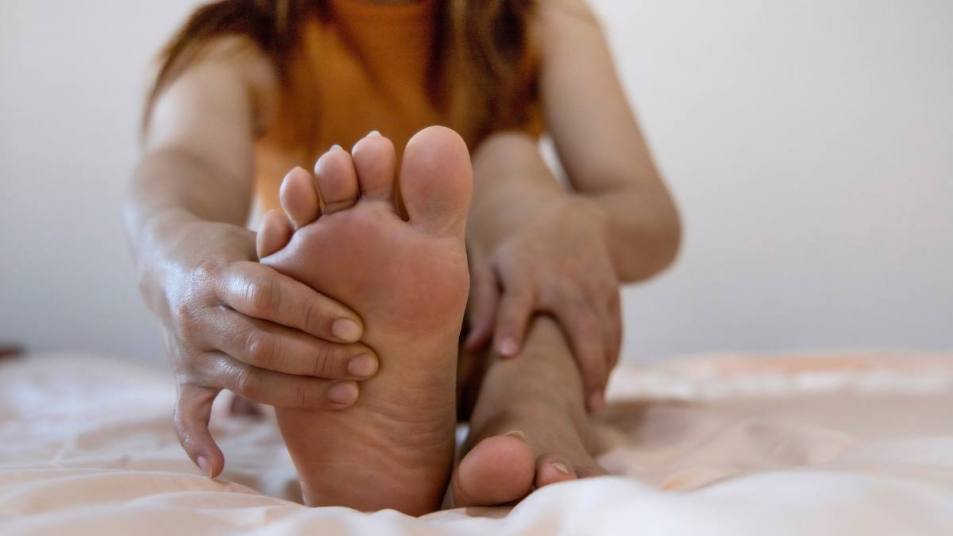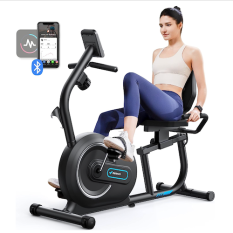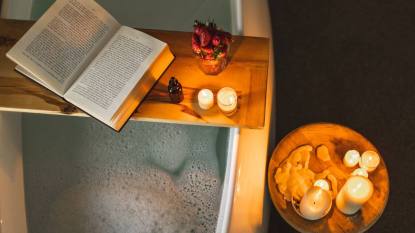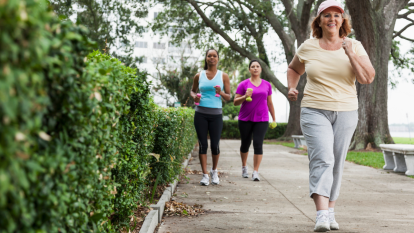Pain In The Ball of Your Foot? It Could Be Morton’s Neuroma
Plus, the supplements that can ease nerve pain and help restore your mobility

Foot pain is one of the most common musculoskeletal problems, affecting up to 87% of people during their lives. This pain can occur anywhere, but if it’s in the ball of your foot or between your toes, it might be a condition called Morton’s neuroma. That name sounds scary, but it’s not as bad as you think. And, there are plenty of ways to relieve neuroma-related pain. Here, we break down the top Morton’s neuroma symptoms, plus the best self-care remedies to ease the ache.
What is Morton’s neuroma?
Morton’s neuroma is inflammation of one of the nerves between your toes, most commonly, the nerve between your third and fourth toes. As the nerve tissue swells and thickens, it’s more likely to rub against the surrounding tissues, causing a burning sensation when you stand or walk.
“This burning sensation is often felt more intensely on the underside or ball of the foot,” says Elizabeth Daughtry, DPM, FACFAS, a practicing podiatrist and board-certified podiatric surgeon. “Morton’s neuroma is generally not related to a specific injury, but rather is a result of foot type, shoe choice and activity.”
Risk factors for Morton’s neuroma
1. Foot type
Everyone’s feet are shaped differently. Some folks have flat feet while others have narrow feet or high-arches. Certain foot shapes are more susceptible to Morton’s neuroma. For instance, Dr. Daughtry says people with wide feet often have to squeeze into their shoes. This presses the toes together, irritating the joints, soft tissues and surrounding nerves. Over time, this compression causes nerve inflammation, and in some cases, Morton’s neuroma.
Related: Foot Doctors Share 6 Ways to Ease Toe Cramps & What It Means When the Pain Strikes After Exercise
2. Shoe choice
Shoes that are narrow, like high heels, for example, squeeze your toe bones together. Dr. Daughtry says this excess pressure can further irritate the nerve if you have a neuroma. Wearing shoes with plenty of toe room often helps. (more on that below).
3. Activity
Certain exercises, like running and hiking, place repetitive pressure on the ball of your foot. “This can exacerbate neuroma pain, especially if your shoes lack the proper shock absorption and cushioning needed to protect the ball of the foot,” explains Dr. Daughtry.
10 signs you may have Morton’s neuroma
Morton’s neuroma presents several telltale symptoms, including:
- Numbness or tingling in the toes or ball of the foot
- Burning or shooting pain in the toes or ball of the foot
- A feeling of fullness in the toes
- A sensation your toes are asleep
- Feeling like your sock is folded up or like there’s something in your shoe, such as a rock
- The urge to take your shoes off and massage the ball of your foot
- Pain that worsens when wearing shoes
- Toe cramps
- Spreading of the toes near the painful area
- Decreased walking ability and mobility
How common is Morton’s neuroma?
Morton’s neuroma isn’t as well-known as bunions and plantar fasciitis, but it’s quite common. “About 30% of the general population has Morton’s neuroma,” says Sharrona Williams, MD, a practicing orthopedic surgeon at Wilmington Health, specializing in foot and ankle care. “They are approximately eight times more common in women than men.”
If you have Morton’s neuroma symptoms, acting quickly is essential, since the thickening of the nerve tissue often worsens over time. There’s no way to “cure” a neuroma, but ongoing treatment can significantly reduce or even eliminate pain. Even better? The outlook is quite positive. “Most folks can treat their Morton’s neuroma conservatively,” Dr. Williams says. “Approximately 80-85% don’t require surgery.”
5 home remedies for Morton’s neuroma pain
Here are several expert-approved tips for keeping Morton’s neuroma pain to a minimum:
1. Wear shoes with these 2 features
Dr. Daughtry says wearing appropriate shoes is one of the easiest ways to stop neuroma pain and prevent it from worsening. Specifically, she recommends buying shoes with two key features — a wide toe box and cushioning for shock absorption.
“Shoes with a wide toe box accommodate deformities such as bunions and hammertoes. The wider toe box also reduces pressure on the toes and metatarsals (toe joints), thus reducing irritation of the neuroma,” she explains. Similarly, cushioning provides padding for the bottom of your foot, reducing pressure every time you take a step.
One to try: Naot Galaxy. “Naot has a great latex and cork footbed perfect for those dealing with neuroma symptoms,” Dr. Daughtry says. “It has an elevated center that reduces pressure on the ball of the foot and provides great shock absorption.”
Since buying new shoes can be pricey, do your research first. Once you find a brand and style of shoe that you like, Dr. Daughtry recommends shopping for last year’s model which is often deeply discounted.
2. Nourish your nerves
Meredith Warner, MD, a board-certified orthopedic surgeon based in Baton Rouge, Louisiana, and the author of Bone on Bone: An Orthopedic Surgeon’s Guide to Avoiding Surgery And Healing Pain Naturally, says she often recommends nutritional supplements to manage neuroma pain. “Magnesium, B12, alpha-lipoic acid (ALA) and palmitoylethanolamide (PEA) are all great supplements for treating nerve symptoms,” she explains.
Several studies have confirmed these supplements’ benefits in managing nerve pain, like that caused by Morton’s neuroma. For instance, a review in Nutrients concluded that vitamin B12 could alleviate nerve pain and support nerve regeneration. Another study in Antioxidants found that ALA effectively reduced nerve pain thanks to its antioxidant (aka cell-protecting) properties.
Research on magnesium and PEA found similar benefits. However, everyone responds differently to these treatments. Talk to your doctor first if you’re considering taking a new supplement.
3. Stretch your feet
Stretching might not seem like an obvious treatment for Morton’s neuroma pain, but Dr. Warner says it “can help a great deal.”
The benefits of stretching are threefold. First, it takes the pressure off the swollen nerve fiber (neuroma). Second, it increases circulation to your foot, providing oxygen and nutrient-rich blood that promotes healing. Third, it strengthens your foot muscles, making it easier to stand and walk comfortably.
An easy stretch, like toe spacing, is a good place to start. All you need is a sock or a piece of similarly thick fabric. Interlace the sock (or fabric) between your toes and leave it there for 5-10 minutes, twice daily, once in the morning and once at night. That’s it! This stretch increases the space between your toes, easing pressure on the Morton’s neuroma and relieving pain.
The video below explains how to do it (starting at 0.46 seconds).
As you get more comfortable, try ankle dorsiflexion with foot pronation. This exercise stretches your foot and ankle, increasing your general range of motion. The more mobile your ankle, is the less pressure you place on the ball of your foot when standing and walking.
For this stretch, get into a kneeling position with one knee on the floor and the other bent at a 90-degree angle. Then, place a folded-up washcloth underneath the ball of your foot on the knee that’s bent. Once the washcloth is in position, slowly lean forward, allowing the bottom of your foot to relax and flatten on the ground. Hold the stretch for 5-10 seconds, relax, and repeat.
The same video explains how to do it (starting at 3:35).
Related: 10 Best Foot Massagers to Soothe Your Soles
4. Try inserts or pads
Morton’s neuroma pain is often exacerbated by your gait (how you walk). Because neuromas are located in the ball of the foot, they experience pressure each time your foot hits the ground. Over-the-counter (OTC) shoe inserts or metatarsal pads can provide relief if you don’t want to buy a new pair of shoes.
Dr. Daughtry’s recommendation: Look for shoe inserts that feature “domelike padding in the arch area.” Extra cushioning in the ball and arch of the foot absorbs shock and eases pressure on your toe joints. Insert to try: Kelaide Morton’s Neuroma Inserts
Metatarsal pads provide similar benefits, by repositioning the shock-absorbing tissues on the bottom of your feet. These pads are less cumbersome than shoe inserts but need to be positioned properly. Otherwise, Dr. Warner says they can worsen the pain in the ball of your foot. Metatarsal pad to try: Dr. Scholl’s Pain Relief Orthotics for Ball of Foot Pain.
If the pain in the ball of your foot continues even after using OTC shoe inserts, ask your doctor about custom orthotics. Custom orthotics are prescription shoe inserts designed specifically for your feet.
5. Use ‘house shoes’

Wearing shoes at home might seem strange, but going barefoot often makes Morton’s neuroma pain worse. Without the extra support that shoes provide, the bones, joints, tendons and other tissues in your feet experience significant wear-and-tear, increasing the risk of further complications.
You don’t even have to wear shoes with laces. Sandals and slip-on clogs are great alternatives; just make sure the house shoes you choose have plenty of toe room. Another feature worth investing in? Rocker-bottom style shoes. Dr. Warner says Dansko clogs are a great example. They slip on easily and feature a rocker-bottom design that takes pressure off the forefoot.
When to see a doctor about Morton’s neuroma
Most cases of Morton’s neuroma pain improve with at-home treatments. However, if your symptoms continue for more than a few days after making these changes, contact your doctor or a podiatrist. Sometimes, more invasive procedures are needed. For example, corticosteroid injections can provide pain relief for weeks and sometimes months. Rarely, surgery is needed. “The good news is that if surgery is required, it’s a small incision and a relatively fast recovery with typically good outcomes,” Dr. Warner says.
For more ways to combat foot pain naturally:
Joint Pain + Rash May Be Early Warning Signs of Psoriatic Arthritis — Here’s What Can Help
What Is Poor Foot Posture, and Is It Causing Your Bunions? Here’s How To Retrain Your Feet
Expert Advice: ‘My Hands and Feet Are Occasionally Tingly. What’s Causing It?’
This content is not a substitute for professional medical advice or diagnosis. Always consult your physician before pursuing any treatment plan.













